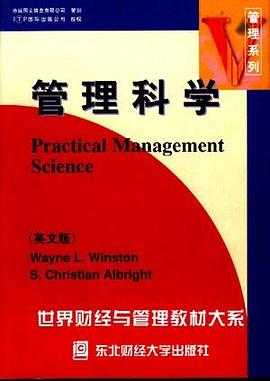

具體描述
著者簡介
圖書目錄
Bfief Contents
1 IntroducNontoModeling
2 Introducfion to Lineer Programming
3 Linear Progfamming Fomulonons
4 Networh Models
5 IntegerProgrammingModGls
6 NonllnearProgrammingModels
7 Muitiple-Objective Decision Making
8 DecisjonMakingUnderUncertointy
9 Deterministic Inventoru Models
10 Probabilistic Inventory Models
11 OueueingModels
12 Simulation
13 SimulaNon with Add-ins
14 Forecasting Models
Index
1 Introduction to modeling
1.1 A Waiting Line Example
1.2 The Seven-Step Modeling Process
1.3 Successful Management Science Applications
1.4 Why Study Management Science?
1.5 Conclusion
References
2 IntroducNon to Linear Programming
2.1 Introduction
2.2 A Brief History of Linear Programming
2.3 Introduction to LP Modeling
2.4 The Linear Assumptions
2.5 Graphical Solution Method
2.6 Solver Reports and Sensitivity Analysis
2.7 Sensitivity Analysis with Graphs
2.8 Infeasibility and Unboundedness
2.9 A Multiperiod Production Problem
2.10 A Decision Support System
2.11 Conclusion
Review Problems
Appendix: What's Best! for Lotus
Case Study: Shelby Shelving
References
3 Linear Progromming Formulations
3.1 Introduction
3.2 Static Workforce Scheduling
3.3 Blending Problems
3.4 Production Process Models
3.5 Aggregate Planning Models
3.6 Dynamic Workforce Planning Models
3.7 A Dynamic Financial Model
3.8 Data Envelopment Analysis (DEA)
3.9 Conclusion
Review Problems
Case Study: Lakefield Corporation's Oil Trading Desk
Case Study: Foreign Currency Trading
References
4 Nefworh models
4.1 Introduction
4.2 The Transportation Model
4.3 A Dynamic Inventory Model
4.4 The Assigmnent Model
4.5 The Critical Path Model (CPM)
4.6 The Minimum Cost Network Flow Model
4.7 The Maximum Flow Model
4.8 The Shortest Path Model
4.9 Conclusion
Review Problems
Case Study: Optimized Motor Carrier Selection at Westvaco
References
5 Integer Programming Models
5.1 Introduction
5.2 Capital Budgeting Models
5.3 The Fixed-Charge Model
5.4 The Lockbox Problem
5.5 The Warehouse Location Problem
5.6 Set Covering Problems
5.7 Either-Or Constraints
5.8 Condusion
Review Problems
Case Study: Giant Motor Company 1
References
6 llonlinear Programmlng Models
6.1 Introduction
6.2 Basic Ideas of Nonlinear Optmuzation
6.3 Managerial Economics Applications
6.4 Salesforce Allocation
6.5 Facility Location Models
6.6 Improving Product Quality
6.7 Estimatmg the Beta of a Stock
6.8 Rating Sports Teams
6.9 Finding Implied Stock Volatilities
6.10 Portfolio Optimization
6.11 Portfolio Optimization: The Scenario Approach
6.12 Portfolio Optimization with Transaction Costs
6.13 Conclusion
Review Problems
Case Study: GMS Stock Hedging
Case Study: Durham Asset Management
References
7 Mulfiple-Obiective Oecision making
7.1 Introduction
7.2 Goal Programming
7.3 Pareto Optimality and Tr-ade-off Curves
7.4 The Analytic Hierarchy Process
7.5 Conclusion
Review Problems
Case Study: Play Time Toy Company
References
8 Decision Mahing Under Uncertainru
8.1 Introduction
8.2 Elements of a Decision Analysis
8.3 Assessing Probabilities (Optional)
8.4 Decision Analysis Examples
8.5 Bayes' Rule
8.6 Incorporating Attitudes Toward Risk
8.7 Conclusion
Review Problems
Case Study: Giant Motor Company ll
References
9 Deterministic invenloru Models
9.1 Introduction
9.2 Categories of Inventory Models
9.3 Costs Involved in Inventory Models
9.4 The Basic EOQ Model
9.5 EOQ Models with Quantity Discounts
9.6 EOQ Model with Shortages Allowed
9.7 Reducing the Setup Cost
9.8 Synchronizing Orders for Several Products
9.9 Conclusion
Review Problems
Case Study: Subway Token Hoarding
References
10 Pfobabilistic Invenhoru) Models
l0.1 Introduction
l0.2 The Newsvendor Model
l0.3 Analysis of (R, Q) Policies
lO.4 A Conclusion
Review Problems
Case Study: Retail Pricing Using Retailer
References
11 Queueing Models
11.1 Introduction
11.2 Elements of Queueing Models
11.3 Short-Run Versus Steady-State Behavior
11.4 The Exponential Distribution
11.5 Important Queueing Relationships
11.6 The Basic Single-Server Model
11.7 A Multiple-Server Model
11.8 Variations of the Basic Models
11.9 TheErlangLossModel
11.10 Conclusion
Review Problems
Case Study: The Catalog Company Problem
References
12 Simulotion
12.1 Introduction
12.2 Actual Applications of Simulation
12.3 Random Numbers
12.4 Introduction to Spreadsheet Simulation
12.5 Generating Other Distributions
12.6 Simulation and Bidding
12.7 Deming's Funnel Experiment
12.8 Simulating the Length of a Project
12.9 Investing in the Stock Market
12.10 Simulating Cash Flows
12.11 Queueing Simulation
12.12 Conclusion
Revie Problems
Case Study: Ski Jacket Production
Case Study: The College Fund Investment Decision
Case Study: Ebony Bath Soap
Case Study: Bond Investment Strategy
Refer ences
13 Slmulation With Rdd-ins
13.1 Introduction
13.2 Simulating an Income Statement
13.3 The Newsvendor Model with (a)RISK
13.4 Financial Planning Simulations
13.5 A Component Redundancy Simulation
13.6 Simulating the Game of Craps
13.7 A Cash Balance Simulation
13.8 Simulating Stock Prices and Options
13.9 Simulating Correlated Values
13.10 A Market Share Simulation
13.11 Conclusion
Review Problems
References
14 Forecastino Models
14.1 Introduction
14.2 Time Series Notation
14.3 Moving-Average Method
14.4 Simple Exponential Smoothing
14.5 Holt's Method for Trend
14.6 Winter's Method for Seasonality
14.7 Simple Linear Regression
14.8 Fitting Nonlinear Relationships
14.9 Multiple Regression
14.10 Categorical Independent Variables
14.11 Multiplicative Models
14.12 Conclusion
Review Problems
Reference
Index
· · · · · · (收起)
1 IntroducNontoModeling
2 Introducfion to Lineer Programming
3 Linear Progfamming Fomulonons
4 Networh Models
5 IntegerProgrammingModGls
6 NonllnearProgrammingModels
7 Muitiple-Objective Decision Making
8 DecisjonMakingUnderUncertointy
9 Deterministic Inventoru Models
10 Probabilistic Inventory Models
11 OueueingModels
12 Simulation
13 SimulaNon with Add-ins
14 Forecasting Models
Index
1 Introduction to modeling
1.1 A Waiting Line Example
1.2 The Seven-Step Modeling Process
1.3 Successful Management Science Applications
1.4 Why Study Management Science?
1.5 Conclusion
References
2 IntroducNon to Linear Programming
2.1 Introduction
2.2 A Brief History of Linear Programming
2.3 Introduction to LP Modeling
2.4 The Linear Assumptions
2.5 Graphical Solution Method
2.6 Solver Reports and Sensitivity Analysis
2.7 Sensitivity Analysis with Graphs
2.8 Infeasibility and Unboundedness
2.9 A Multiperiod Production Problem
2.10 A Decision Support System
2.11 Conclusion
Review Problems
Appendix: What's Best! for Lotus
Case Study: Shelby Shelving
References
3 Linear Progromming Formulations
3.1 Introduction
3.2 Static Workforce Scheduling
3.3 Blending Problems
3.4 Production Process Models
3.5 Aggregate Planning Models
3.6 Dynamic Workforce Planning Models
3.7 A Dynamic Financial Model
3.8 Data Envelopment Analysis (DEA)
3.9 Conclusion
Review Problems
Case Study: Lakefield Corporation's Oil Trading Desk
Case Study: Foreign Currency Trading
References
4 Nefworh models
4.1 Introduction
4.2 The Transportation Model
4.3 A Dynamic Inventory Model
4.4 The Assigmnent Model
4.5 The Critical Path Model (CPM)
4.6 The Minimum Cost Network Flow Model
4.7 The Maximum Flow Model
4.8 The Shortest Path Model
4.9 Conclusion
Review Problems
Case Study: Optimized Motor Carrier Selection at Westvaco
References
5 Integer Programming Models
5.1 Introduction
5.2 Capital Budgeting Models
5.3 The Fixed-Charge Model
5.4 The Lockbox Problem
5.5 The Warehouse Location Problem
5.6 Set Covering Problems
5.7 Either-Or Constraints
5.8 Condusion
Review Problems
Case Study: Giant Motor Company 1
References
6 llonlinear Programmlng Models
6.1 Introduction
6.2 Basic Ideas of Nonlinear Optmuzation
6.3 Managerial Economics Applications
6.4 Salesforce Allocation
6.5 Facility Location Models
6.6 Improving Product Quality
6.7 Estimatmg the Beta of a Stock
6.8 Rating Sports Teams
6.9 Finding Implied Stock Volatilities
6.10 Portfolio Optimization
6.11 Portfolio Optimization: The Scenario Approach
6.12 Portfolio Optimization with Transaction Costs
6.13 Conclusion
Review Problems
Case Study: GMS Stock Hedging
Case Study: Durham Asset Management
References
7 Mulfiple-Obiective Oecision making
7.1 Introduction
7.2 Goal Programming
7.3 Pareto Optimality and Tr-ade-off Curves
7.4 The Analytic Hierarchy Process
7.5 Conclusion
Review Problems
Case Study: Play Time Toy Company
References
8 Decision Mahing Under Uncertainru
8.1 Introduction
8.2 Elements of a Decision Analysis
8.3 Assessing Probabilities (Optional)
8.4 Decision Analysis Examples
8.5 Bayes' Rule
8.6 Incorporating Attitudes Toward Risk
8.7 Conclusion
Review Problems
Case Study: Giant Motor Company ll
References
9 Deterministic invenloru Models
9.1 Introduction
9.2 Categories of Inventory Models
9.3 Costs Involved in Inventory Models
9.4 The Basic EOQ Model
9.5 EOQ Models with Quantity Discounts
9.6 EOQ Model with Shortages Allowed
9.7 Reducing the Setup Cost
9.8 Synchronizing Orders for Several Products
9.9 Conclusion
Review Problems
Case Study: Subway Token Hoarding
References
10 Pfobabilistic Invenhoru) Models
l0.1 Introduction
l0.2 The Newsvendor Model
l0.3 Analysis of (R, Q) Policies
lO.4 A Conclusion
Review Problems
Case Study: Retail Pricing Using Retailer
References
11 Queueing Models
11.1 Introduction
11.2 Elements of Queueing Models
11.3 Short-Run Versus Steady-State Behavior
11.4 The Exponential Distribution
11.5 Important Queueing Relationships
11.6 The Basic Single-Server Model
11.7 A Multiple-Server Model
11.8 Variations of the Basic Models
11.9 TheErlangLossModel
11.10 Conclusion
Review Problems
Case Study: The Catalog Company Problem
References
12 Simulotion
12.1 Introduction
12.2 Actual Applications of Simulation
12.3 Random Numbers
12.4 Introduction to Spreadsheet Simulation
12.5 Generating Other Distributions
12.6 Simulation and Bidding
12.7 Deming's Funnel Experiment
12.8 Simulating the Length of a Project
12.9 Investing in the Stock Market
12.10 Simulating Cash Flows
12.11 Queueing Simulation
12.12 Conclusion
Revie Problems
Case Study: Ski Jacket Production
Case Study: The College Fund Investment Decision
Case Study: Ebony Bath Soap
Case Study: Bond Investment Strategy
Refer ences
13 Slmulation With Rdd-ins
13.1 Introduction
13.2 Simulating an Income Statement
13.3 The Newsvendor Model with (a)RISK
13.4 Financial Planning Simulations
13.5 A Component Redundancy Simulation
13.6 Simulating the Game of Craps
13.7 A Cash Balance Simulation
13.8 Simulating Stock Prices and Options
13.9 Simulating Correlated Values
13.10 A Market Share Simulation
13.11 Conclusion
Review Problems
References
14 Forecastino Models
14.1 Introduction
14.2 Time Series Notation
14.3 Moving-Average Method
14.4 Simple Exponential Smoothing
14.5 Holt's Method for Trend
14.6 Winter's Method for Seasonality
14.7 Simple Linear Regression
14.8 Fitting Nonlinear Relationships
14.9 Multiple Regression
14.10 Categorical Independent Variables
14.11 Multiplicative Models
14.12 Conclusion
Review Problems
Reference
Index
· · · · · · (收起)
讀後感
評分
評分
評分
評分
評分
用戶評價
评分
评分
评分
评分
评分
相關圖書
本站所有內容均為互聯網搜索引擎提供的公開搜索信息,本站不存儲任何數據與內容,任何內容與數據均與本站無關,如有需要請聯繫相關搜索引擎包括但不限於百度,google,bing,sogou 等
© 2025 book.quotespace.org All Rights Reserved. 小美書屋 版权所有




















